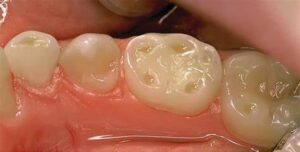What is it?
Dental erosion refers to the gradual loss of tooth enamel due to chemical processes rather than bacterial action, which is typical of dental decay. It occurs when acids, often from dietary sources or gastric reflux, come into contact with the tooth surface and dissolve the mineral content of the enamel. Dental erosion can lead to tooth sensitivity, discoloration, and an increased risk of cavities and tooth loss if left untreated.
Here are some key points about dental erosion:
- Causes:
- Acidic foods and beverages: Consuming acidic foods and drinks such as citrus fruits, carbonated beverages, fruit juices, vinegar, and sour candies can contribute to dental erosion.
- Gastric reflux: Conditions like gastroesophageal reflux disease (GERD) or bulimia, which involve frequent vomiting or regurgitation of stomach acids, can expose the teeth to acidic substances and contribute to erosion.
- Environmental factors: Exposure to environmental acids, such as industrial pollutants or chlorinated swimming pool water, can also contribute to dental erosion.
- Medications: Certain medications, such as aspirin or vitamin C supplements in chewable form, can be acidic and contribute to erosion if they come into contact with the teeth.
- Dry mouth: Reduced saliva flow, as seen in conditions like xerostomia or as a side effect of medications, can decrease the mouth’s natural buffering capacity and increase susceptibility to erosion.
- Symptoms:
- Tooth sensitivity: Eroded enamel exposes the underlying dentin, which contains nerve endings, leading to increased sensitivity to hot, cold, sweet, or acidic stimuli.
- Discoloration: Teeth may appear yellowish or dull due to thinning enamel and increased visibility of the underlying dentin.
- Rounded or cupped tooth surfaces: Erosion may cause the enamel to wear away unevenly, resulting in rounded or concave areas on the tooth surface.
- Transparency: The edges of the teeth may appear translucent or see-through due to thinning of the enamel.
- Increased risk of cavities: As enamel erodes, the underlying dentin becomes more susceptible to decay, increasing the risk of cavities.
- Diagnosis:
- Diagnosis of dental erosion is typically based on clinical examination, dental history, and visual inspection of the teeth. Your dentist may also inquire about dietary habits, medical conditions, and lifestyle factors that could contribute to erosion.
- Dental X-rays or intraoral cameras may be used to assess the extent of enamel loss and evaluate the condition of the underlying dentin.
- Treatment:
- Treatment of dental erosion aims to prevent further enamel loss, alleviate symptoms, and protect the teeth from decay. Treatment options may include:
- Dietary modifications: Limiting consumption of acidic foods and beverages can help reduce acid exposure and slow the progression of erosion.
- Oral hygiene practices: Brushing with a fluoride toothpaste and using a fluoride mouth rinse can help strengthen enamel and protect against decay.
- Dental restorations: Depending on the severity of erosion and symptoms, your dentist may recommend dental bonding, veneers, or crowns to restore and protect damaged teeth.
- Saliva stimulation: Chewing sugar-free gum or using saliva substitutes can help stimulate saliva flow and improve oral pH balance to reduce acidity.
- Acid-neutralizing agents: Your dentist may recommend prescription or over-the-counter products containing calcium, phosphate, or fluoride to remineralize enamel and neutralize acids.
- Prevention:
- To prevent dental erosion, it’s important to:
- Limit consumption of acidic foods and beverages, and rinse the mouth with water afterward to neutralize acids.
- Use a straw when drinking acidic beverages to minimize contact with the teeth.
- Wait at least 30 minutes to brush your teeth after consuming acidic foods or drinks to avoid further enamel damage.
- Maintain good oral hygiene habits, including regular brushing, flossing, and dental check-ups.
- Seek treatment for conditions like GERD or bulimia that contribute to acid exposure and erosion.
In summary, dental erosion is the gradual loss of tooth enamel due to exposure to acidic substances. It can lead to tooth sensitivity, discoloration, and an increased risk of cavities if left untreated. Prevention and early intervention are essential to slow the progression of erosion and protect the teeth from further damage. If you suspect dental erosion or experience symptoms such as tooth sensitivity or discoloration, it’s important to consult your dentist for evaluation and appropriate treatment.

